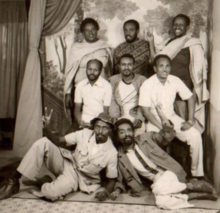| Revision as of 09:41, 18 December 2024 editSamyatilius (talk | contribs)219 editsNo edit summaryTags: Visual edit Mobile edit Mobile web edit← Previous edit | Revision as of 09:44, 18 December 2024 edit undoSamyatilius (talk | contribs)219 editsNo edit summaryTags: Mobile edit Mobile web editNext edit → | ||
| Line 2: | Line 2: | ||
| | conflict = Mandera Assault | | conflict = Mandera Assault | ||
| | partof = ] | | partof = ] | ||
| | image = File:Freed prisoners from Mandheera prison by the SNM (1983).png | |||
| | caption =Northern Prisoners freed from the ] | |||
| | date = 2 January 1983<ref name="GabileyNews">{{cite web|url=https://www.gabileynewsonline.com/2020/10/barnaamij-ku-saabsan-jabintii-jeelka-mandheera-1983-kii/wararka/admin/103135/|title=Barnaamij ku saabsan Jabintii Jeelka Mandheera 1983-kii|publisher=Gabiley News Online|accessdate=17 December 2024}}</ref> | | date = 2 January 1983<ref name="GabileyNews">{{cite web|url=https://www.gabileynewsonline.com/2020/10/barnaamij-ku-saabsan-jabintii-jeelka-mandheera-1983-kii/wararka/admin/103135/|title=Barnaamij ku saabsan Jabintii Jeelka Mandheera 1983-kii|publisher=Gabiley News Online|accessdate=17 December 2024}}</ref> | ||
| | place = ], near ], ]<ref name="LongLive">{{cite web|url=https://www.longlivesomaliland.com/Jabintii%20Jeelka%20Madheera-Q-3aad.htm|title=Jabintii Jeelka Madheera-Qaybta 3aad|publisher=Long Live Somaliland|accessdate=17 December 2024}}</ref> | | place = ], near ], ]<ref name="LongLive">{{cite web|url=https://www.longlivesomaliland.com/Jabintii%20Jeelka%20Madheera-Q-3aad.htm|title=Jabintii Jeelka Madheera-Qaybta 3aad|publisher=Long Live Somaliland|accessdate=17 December 2024}}</ref> | ||
Revision as of 09:44, 18 December 2024
| Mandera Assault | |||||||
|---|---|---|---|---|---|---|---|
| Part of Somaliland War of Independence | |||||||
 Northern Prisoners freed from the Mandera Prison | |||||||
| |||||||
| Belligerents | |||||||
|
|
| ||||||
| Commanders and leaders | |||||||
|
|
Unknown local prison authorities | ||||||
| Strength | |||||||
| ~50 SNM commandos | Unknown | ||||||
| Casualties and losses | |||||||
| Minimal |
Moderate (exact numbers unknown) Over 700 freed (SNM claim); ~12 freed (independent estimates) | ||||||
The Mandera Prison Assault was a pivotal military operation conducted by the Somali National Movement (SNM) on 2 January 1983 during the early stages of the Somaliland War of Independence. The assault targeted Mandera Prison, a high-security detention center near Berbera in northern Somalia, where numerous political dissidents from Somaliland were held. Under the command of Colonel Mohamed Hashi Lihle, SNM commando units freed over 700 prisoners, though independent sources estimate that around a dozen prominent political detainees escaped. The operation, considered the SNM's first major military success, significantly boosted the morale of the resistance movement and highlighted the deteriorating grip of the Somali government in the northern regions.
Background
By the early 1980s, dissatisfaction with the government of Siad Barre had reached a breaking point in northern Somalia, particularly among the Isaaq clan. Barre’s regime marginalized the north politically and economically while using repression and imprisonment to quell dissent. The Somali National Movement (SNM) was founded in 1981 in response to these grievances, gaining widespread support in the northern regions. Mandera Prison, located near Berbera, symbolized the regime's oppressive policies, as it held hundreds of political prisoners from Somaliland. The SNM identified the prison as a strategic target to both free detainees and establish their credibility as a resistance force.
The Assault
The Mandera Prison Assault was a well-coordinated raid executed by a small force of SNM commandos under the leadership of Colonel Mohamed Hashi Lihle. On the morning of 2 January 1983, the SNM launched simultaneous attacks on:
- Mandera Prison – to free political detainees.
- Cadaadle Armoury, a nearby facility, to seize weapons and ammunition.
The SNM succeeded in liberating over 700 prisoners according to their reports, although independent sources suggest that only about 12 high-value political prisoners managed to escape. Lihle addressed the freed prisoners, offering them three options:
- Join the SNM and continue the fight.
- Return to their families, with SNM assistance.
- Rejoin the government forces, though with a warning of potential future attacks.
The commandos simultaneously raided the Cadaadle armoury, acquiring a significant but unspecified quantity of arms and ammunition, which strengthened their military capacity.
Casualties and Results
- Prisoners Freed:
- SNM Claim: Over 700.
- Independent Estimates: Approximately 12 high-value prisoners.
- Casualties:
- Somali Government Forces: Moderate losses; exact numbers unknown.
- SNM Commandos: Minimal casualties.
- Weapons Seized: An undetermined amount of arms and ammunition was taken from the Cadaadle armoury.
The success of the operation was a significant propaganda victory for the SNM, bolstering their reputation among the Isaaq population and inspiring further resistance to Barre's regime.
Aftermath
The Mandera Prison Assault was instrumental in shaping the course of the Somaliland War of Independence. It demonstrated the SNM’s ability to carry out high-profile operations, instilled fear within Barre’s government, and solidified support for the SNM among Somalilanders. The raid also marked the emergence of military heroes like Colonel Mohamed Hashi Lihle and Captain Ibrahim Kodbur, who played central roles in subsequent battles. Over the next six years, the SNM launched numerous successful raids from their Ethiopian bases, steadily eroding Barre’s control in the north.
Legacy
The Mandera Prison Assault is remembered as a symbol of defiance and determination in Somaliland’s struggle for independence. It is frequently cited as the SNM’s most striking initial military success, laying the groundwork for future campaigns and inspiring widespread resistance to Barre’s regime.
References
- ^ "Shantii June: Jebintii Jeelka Mandheera". Samotalis Blog. Retrieved 17 December 2024.
- ^ "Mandera Prison Assault". Red Sea Online. Retrieved 17 December 2024.
- ^ "Barnaamij ku saabsan Jabintii Jeelka Mandheera 1983-kii". Gabiley News Online. Retrieved 17 December 2024.
- ^ "Jabintii Jeelka Madheera-Qaybta 3aad". Long Live Somaliland. Retrieved 17 December 2024.
- ^ "The 28th Anniversary of the Badbaado Mission: Breaking the Mandhera Prison in 1983". Somalia Online. Retrieved 17 December 2024.